When was the last time you saw a Facebook ad, clicked, arrived on a product page, read positive things, and made a purchase?
Odds are you have probably done so fairly recently, which means you have been sucked in and spit out of someone’s digital marketing funnel – a multi-step system which guides a prospect towards a specific action in a non-invasive manner.
Wait, what? Can someone please explain this in plain language?

I got you.
A digital marketing funnel is essentially the way you design your marketing system to guide potential customers from becoming aware of your business to eventually buying what you have to offer. The idea is to direct them towards the end goal in the most efficient way possible.
I’ve had clients take months to finally make the decision to try out my services. After I educated myself on marketing funnels and created one for my business, things became different: I now get emails saying, “I’ve been visiting your site for quite some time. Do you have a moment to talk about an SEO project?” Additionally, the funnel has allowed me to weed out those who aren’t truly interested in hiring my services.
If you haven’t set up a marketing funnel yet, NOW is a great time to take the leap and build one for your business.
In this post, I will talk about the differences between traditional and digital funnels, educate you on funnel anatomy, and teach you everything you need to know to build your very first digital marketing funnel.
Here we go.
Digital vs. traditional marketing funnels.
The traditional marketing funnel dates back to the 1800s when your only options to shop were local stores. Magazines and direct mails made you aware that a certain outlet had your favorite product in stock, and you’d simply go there to make a purchase. Comparison shopping was limited by geography. If you visited a shop to buy a product, you might compare alternatives on the shelf, but you were unlikely to head out and visit another store to find a new option entirely.
It used to be the same with services: you had to visit a company’s office to inquire about consultancy and usually paid a high fee because you couldn’t find any other option in your area.
The traditional funnel worked perfectly for a long period, but the rise of the internet has impacted it dramatically.
Today, you can look up and compare thousands of competing products from hundreds of different supplies without leaving your home. You can also read reviews, browse coupons and have the order delivered at your doorstep. In case of services, you can request an online quote and take as much time as you need to make a buying decision because thousands of service providers from around the world are competing for your business.
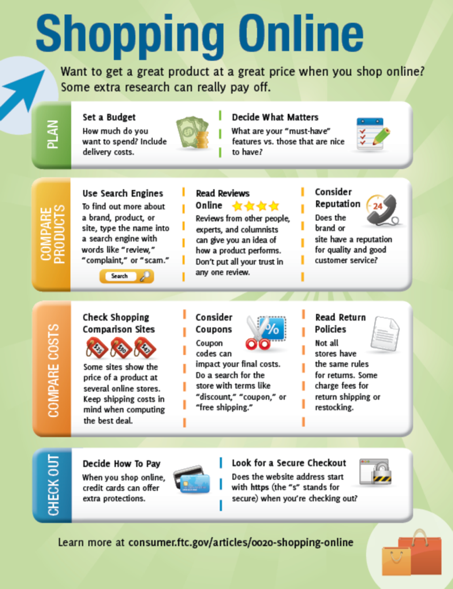
With so many options, companies had to start competing for buyer attention in new ways. This lead to the birth of the digital marketing funnel – a system that focuses on educating, engaging, and embracing the savvy consumer who experiences the act of shopping in new ways.
The major difference between the two is that the digital marketing funnel focuses on the modern shopper, who’ll go through many different touchpoints before buying a product or service. Hence, you need to not only ensure that all your digital interactions with potential clients are authentic, transparent, and valuable, you also need to have a correctly working funnel in place to get the most out of your marketing efforts.
The anatomy of a digital marketing funnel.
There are several variations of digital marketing funnels, but the one I like most has three fundamental stages:
- Top of the funnel (TOFU)
- Middle of the funnel (MOFU)
- Bottom of the funnel (BOFU)
Here’s a quick breakdown of each:
1. Top of the funnel
This is the stage where your potential customers aren’t aware of your product or service, and your marketing efforts are all about introducing your company to as many people as possible.
This can be done in several ways; blog posts on topics your target customers may search, sponsored ads, and podcast appearances are all fantastic ways to increase brand awareness.
Your main goal in the TOFU stage should be to educate, inspire, and entertain your audience.
2. Middle of the funnel
The middle of the funnel is where your target audience moves from having an awareness about your brand to showing an interest in it. They’ll have your webpage open because you managed to impress them at the top of the funnel.
Your job in the MOFU stage is to give enough value that your audience is willing to sign up for your newsletter.
Once you get their emails, send them ebooks, case studies, and other tailored resources that showcase the benefits you can provide. This raises a target customer’s interest in your business, which is key to preparing them for the next stage of a digital marketing funnel.
3. Bottom of the funnel
The bottom of the funnel is where your potential customers are ready to spend money on your offerings.
Your role here is to present your product or service in a way that inspires your audience to make a purchase.
Things like limited-time specials and success stories can give prospective clients enough confidence to pull the trigger. When they do, you’ll get a sales conversion. In most instances, the overall success of a digital marketing funnel is determined by the number of conversions it was able to generate.
I found the perfect visual summary of these marketing funnel stages on inbound marketing expert Kevin Payne’s website.

It’s worth noting that the marketing assets required to move the audience from top to bottom vary widely depending on their persona. For b2c customers, marketing assets might include an Instagram ad or an endorsement from a local celebrity. In the case of b2b buyers, marketing assets need to include things like detailed tutorials and industry reports.
Building a digital marketing funnel (in 5 steps).
Now that you understand how a digital marketing funnel works, use these five steps to build one for your business.
1. Create ads & content.
The primary stage in a digital marketing funnel is all about awareness, so your first step should be to create ads and content. Objective informational and trust-inducing content will point the audience in the right direction and, hopefully, convince them to check out your website.
The list of potential ads and content formats to consider is long:
- Social media ads
- Pay-per-click ads
- Recommendation widgets
- Blog posts
- Videos
- Social media updates
- Quizzes
- Checklists
- Industry studies
What goes into your ads and content will depend on who you’re targeting: consumers or businesses.
For b2c audiences, you can run Facebook and Instagram ads that talk up the benefits of using your product or service. Your blog posts can be witty, personal and upfront. Videos can be on general awareness topics like “how product x helps people get a good night’s sleep.” With recommendation widgets, you can project and amplify your offering to millions of potential customers across premium publishers.
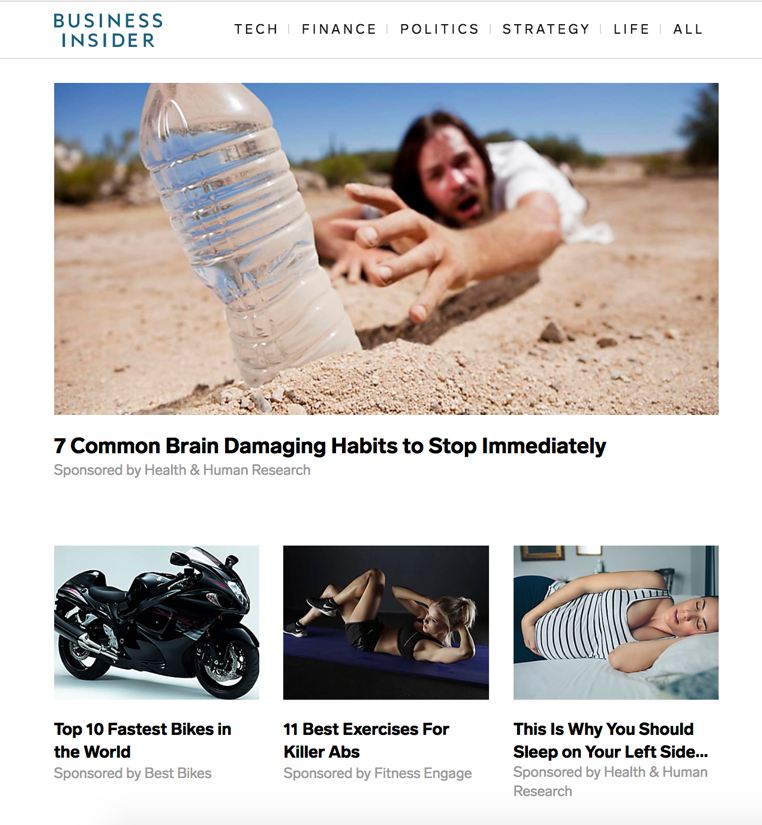
Here’s an example of recommendation widgets in action. They display sponsored content alongside or underneath Business Insider’s editorial posts. Upon clicking, visitors are sent to a landing page on the website of the brand who created the sponsored content.
For b2b audiences, you’ll need to revamp your strategy and/or activate additional channels. You can, for instance, run LinkedIn ads to reach a network of professionals. I highly recommend doing this because LinkedIn is highly popular among businesspeople. In terms of content, you can impress potential clients with data-driven blog posts, research studies and industry reports. You can also set up a recommendation widget to ensure your content goes out to the specific people you are aiming to reach.
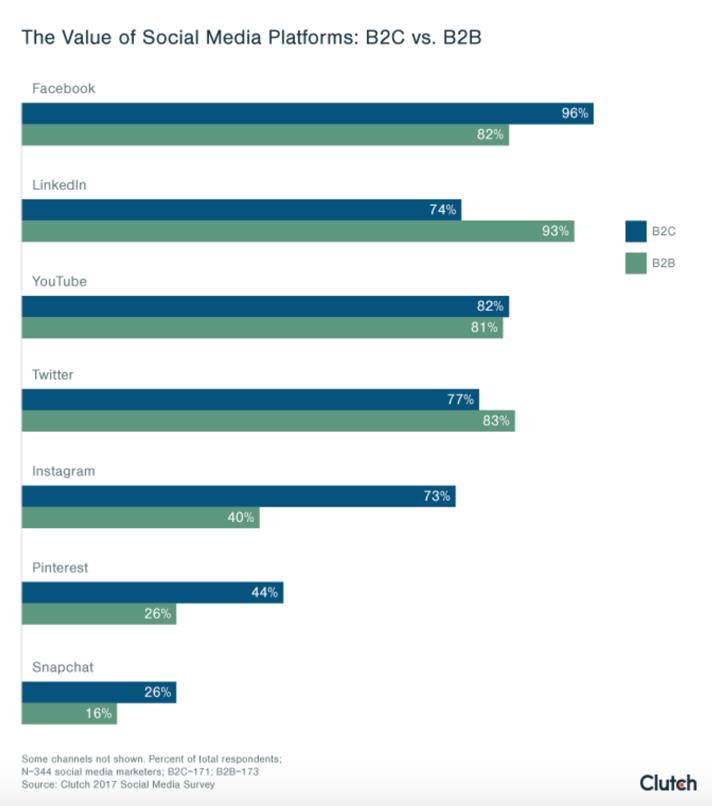
Findings from Clutch’s 2017 social media survey revealed that LinkedIn is the most valuable platform for b2b professionals.
If your awareness stage ads and content are compelling and helpful, it might inspire people to march onward into the next phase of your marketing funnel.
2. Build an enticing offer.
If you want to build a digital marketing funnel that virtually fills itself with high-quality prospects, you need to create an offer that entices people to keep learning about your activities. For example, if I had a copywriting agency, I could offer an ebook titled “The Ultimate Guide to Ecommerce Copywriting.”
The goal of your offer is to capture the interest of incoming visitors by delivering something genuinely valuable. Doing so will incentivize them to enter their contact information and subscribe to receive additional marketing.
Popular examples of offers (lead magnets) include:
- ebooks
- Webinars
- Free trials
- Case studies
- White papers
- Instructional videos
- Reports
- Cheat sheets
- Free-to-use images
- Mini-courses
Again, the nature of your offer will depend on whether you’re targeting b2c or b2b audiences. Business professionals would be likely more interested in white papers and case studies than in ebooks. If you’re really keen on creating an ebook, make sure to include some numbers and industry-related success stories to keep prospects interested.

Social Media Examiner, the world’s largest online social media magazine, offers a free industry report in exchange for visitors’ email.
3. Set up a landing page.
Your landing page is the place where your target audience will arrive when they first click on your ad. It is meant to host your offer, demonstrate your expertise and help people get a better idea of your services, leading to the point where they’re ready to invest in your solution.
The best landing pages include:
- A clear description of the lead magnet you’re offering
- Simple yet eye-catching visuals
- A form for people to enter their contact information
- Trust-builders like testimonials and security badges
- A compelling CTA (call-to-action)
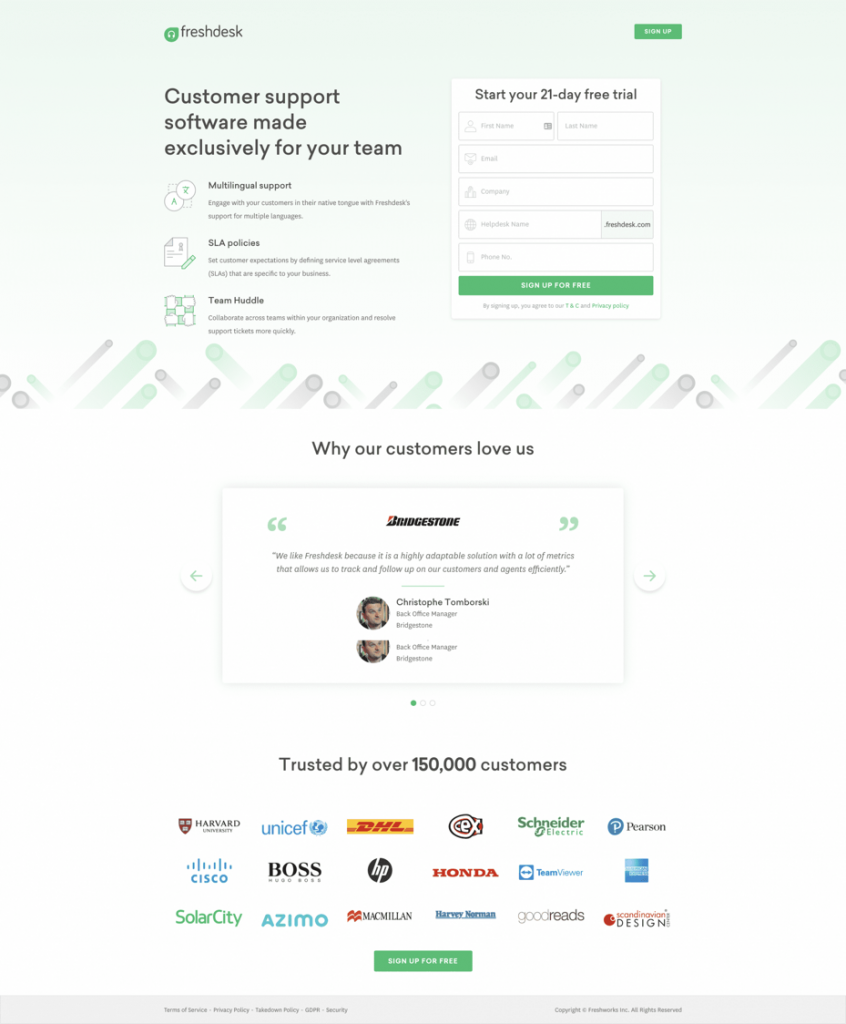
Freshdesk’s landing page has it all. You can see a lead magnet (free trial), eye-catching images, a subscription form, trust-builders (testimonials), and an enticing CTA (I’m certainly interested in signing up for free).
The easiest way to create a landing page is to sign up for a tool that makes building and tweaking your landing page a breeze. I’m a big fan of Unbounce as it gives me loads of templates to choose from. Plus, I’m able to add, customize or remove page components with just a few mouse clicks. Use it to set up a landing page for your marketing funnel. If you want to truly grasp how to design a great landing page, check out this step-by-step guide.
4. Create your email sequence.
Your email sequence is a series of messages that’ll go out to people who sign up for your offer by submitting their contact details. The messages are typically sent in a series of four to seven over the course of about three weeks to nurture prospects and move them towards the bottom of the funnel. Create an email sequence to remind the audience of your existence and keep feeding helpful content to them until they’re ready to buy.
For example, the first email you send to a potential customer can include your lead magnet and some advice on how to get the most out of it. The second email can build on the things that were highlighted in the lead magnet. In the third email, you can send your subscribers a case study that shows the benefits of working with you from a consumer’s perspective. The remaining emails can continue the trust building process until you send them an offer.
The content of the email sequence will be different for a b2c recipient than for a b2b subscriber.
A b2c email sequence can tap into the emotions of the consumer. They can be visually entertaining and include super high energy copy to provoke specific actions. On the other hand, a b2b email sequence requires thought leadership and needs to address the pain point of the buyers it is targeting. Essence of Email has a great article on the differences between the two.
You’d also need to sign up for an email series provider that will automate your email sequence. I recommend AWeber as automated emails (they call them autoresponders) are one of its core features. Use AWeber to set up your email series and push visitors towards the final stage of your digital marketing funnel.
[Insert Image]
Online Money Bee has a great tutorial on how to create autoresponders in AWeber.
5. Connect the dots.
In order for your digital marketing funnel to properly work, you need to connect the different elements so that people signing up for your offer receive the lead magnet and your email sequence gets activated.
Unbounce has an intuitive dashboard that you can use to set up your offer, connect your email service and add any tracking code so that when a visitor signs up the lead magnet delivery, tracking, email capture and message series are all automated.
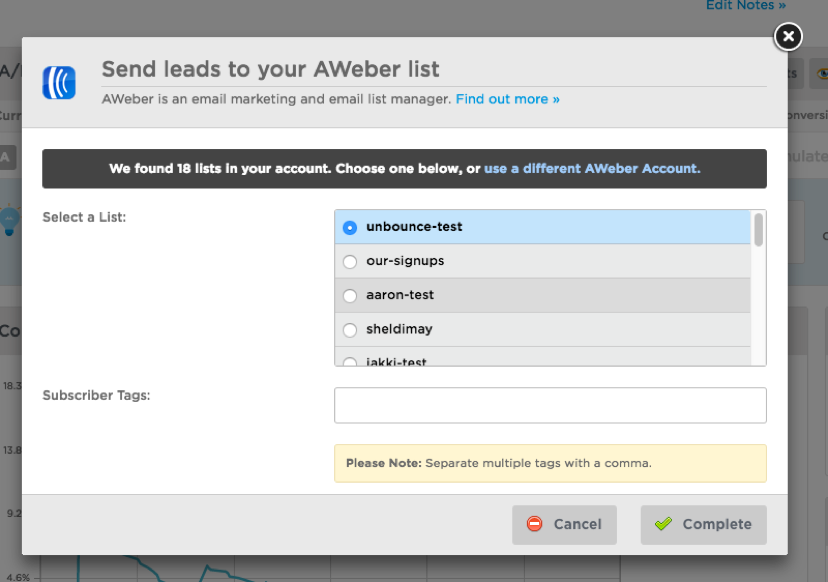
Both Unbounce and AWeber have great tutorials that will help you to connect each of these elements to ensure that your marketing funnel works like a well-oiled machine.
Test away!
Yes, the steps are done, and you have a digital marketing funnel in place. Now you only need to run a few tests to ensure it’s set up correctly. Enter your own contact information on the landing page to check if your lead magnet is sent and that your email sequence works without any hiccups.
Get a friend or two to test it as well.
You’ll want to do all this before driving any real traffic to your funnel, so you can have peace of mind knowing that it works.
Value the funnel. Create something useful and offer it via the right channels and use a marketing funnel to nurture prospects if you want to impact your bottom line in a big, positive way.